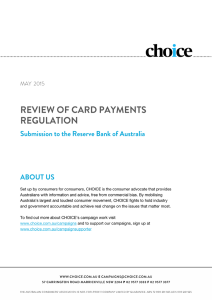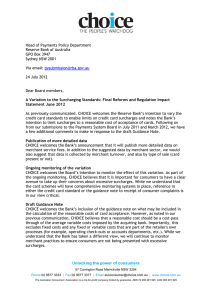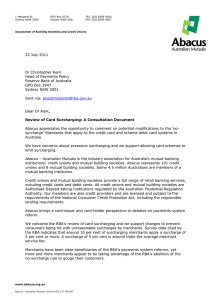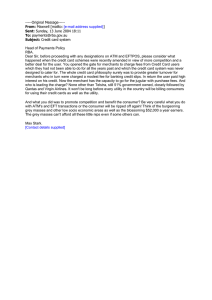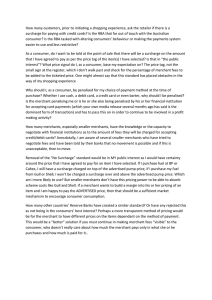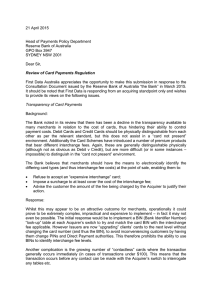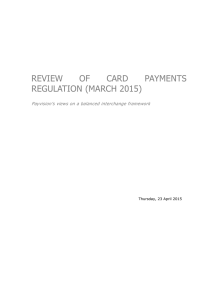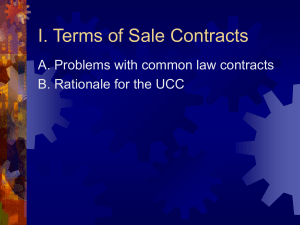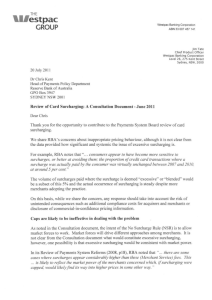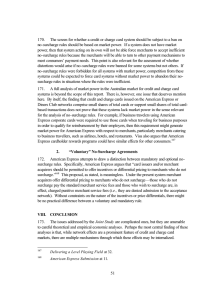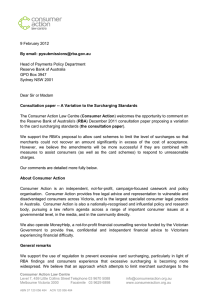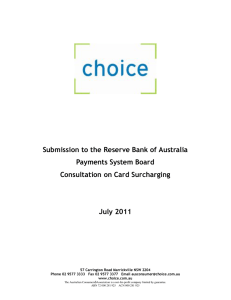A B ’ I
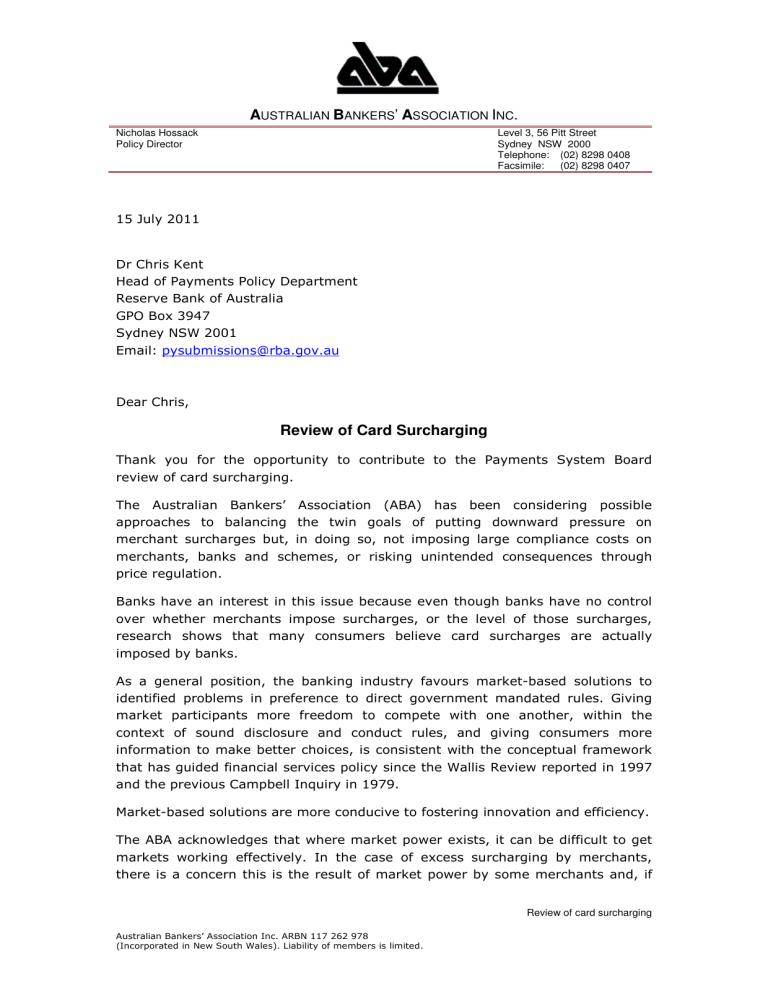
Nicholas Hossack
Policy Director
A
USTRALIAN
B
ANKERS
’ A
SSOCIATION
I
NC
.
Level 3, 56 Pitt Street
Sydney NSW 2000
Telephone: (02) 8298 0408
Facsimile: (02) 8298 0407
15 July 2011
Dr Chris Kent
Head of Payments Policy Department
Reserve Bank of Australia
GPO Box 3947
Sydney NSW 2001
Email: pysubmissions@rba.gov.au
Dear Chris,
Review of Card Surcharging
Thank you for the opportunity to contribute to the Payments System Board review of card surcharging.
The Australian Bankers’ Association (ABA) has been considering possible approaches to balancing the twin goals of putting downward pressure on merchant surcharges but, in doing so, not imposing large compliance costs on merchants, banks and schemes, or risking unintended consequences through price regulation.
Banks have an interest in this issue because even though banks have no control over whether merchants impose surcharges, or the level of those surcharges, research shows that many consumers believe card surcharges are actually imposed by banks.
As a general position, the banking industry favours market-based solutions to identified problems in preference to direct government mandated rules. Giving market participants more freedom to compete with one another, within the context of sound disclosure and conduct rules, and giving consumers more information to make better choices, is consistent with the conceptual framework that has guided financial services policy since the Wallis Review reported in 1997 and the previous Campbell Inquiry in 1979.
Market-based solutions are more conducive to fostering innovation and efficiency.
The ABA acknowledges that where market power exists, it can be difficult to get markets working effectively. In the case of excess surcharging by merchants, there is a concern this is the result of market power by some merchants and, if
Review of card surcharging
Australian Bankers’ Association Inc. ARBN 117 262 978
(Incorporated in New South Wales). Liability of members is limited.
A USTRALIAN B ANKERS ’ A SSOCIATION I NC . 2 this is correct, then there is an argument that more intensive regulatory tools maybe necessary to protect consumer interests.
However, the ABA is of the view that there are alternative market based options available. One such option is discussed below.
1
Disclosure Model option: More accurate disclosure of product prices
Current surcharge disclosure practice
Under the current disclosure requirements for surcharges – as detailed in the
ACCC/ASIC pricing brochure – merchants are required to notify consumers of any applicable surcharges before any transaction is completed and the amount of this surcharge, typically a percentage of the price of the goods and services purchased. There is no obligation on merchants to include surcharges in the advertised or displayed price of the merchant’s goods and services.
While the Consumer and Competition Act 2010 requires merchants to include unavoidable taxes, duties, fees, levies or charges in their advertised prices, costs which can be avoided by the consumer do not need to be added into the advertised price.
While it makes sense that avoidable costs do not need to be disclosed, it is more complicated when it comes to payment instruments. The consumer cannot avoid using a payment instrument when purchasing a good or service, although often there is a choice as to which one is used.
In some cases, card payments can represent over 80 per cent
2
of a merchant’s total payments, all of which are surcharged.
3 In this scenario, to exclude the cost of card payment surcharges in advertising will mean the advertised price will be incorrect for at least 80 per cent of the business’ customers.
Additionally, many businesses have evolved to be fundamentally reliant on payment cards for sales (e.g. online, white and brown good retailers, and travelrelated companies) yet, rather than roll the cost into the general price level, many of these businesses surcharge cards as if they are offering an additional customer service. One explanation of this is that there is a benefit in advertising prices net of surcharges.
Proposed change to disclosure of surcharges
There is a case, therefore, to change the Consumer and Competition Act 2010
4
(the former Trade Practices Act 1974) to require merchants to include in
1
Please note that one ABA member banks indicated to the ABA that it does not support the Disclosure option outlined in this submission.
2
This 80% estimate is anecdotal. The ABA has not verified this figure with any merchants.
3
Note that on-line businesses typically have no facilities for accepting cash payments.
4
The relevant section of the Act states: “…(7) The single price is the minimum quantifiable consideration for the supply of the goods or services at the time of the representation, including each of the following amounts (if any) that is quantifiable at that time:…
…(b) the amount which reflects any tax, duty, fee, levy or charge imposed on the person making the representation in relation to the supply;…”
Review of card surcharging
A USTRALIAN B ANKERS ’ A SSOCIATION I NC . 3 advertised and displayed prices, the consumer cost of the most commonly used payment instrument e.g. a card surcharge.
In many cases, this would mean merchants had to increase prices in order to present the price that consumers are most likely to pay and, given this, it would provide a competitive incentive to lower surcharges towards underlying costs.
The other direct implication of this is that when cash-paying (or other nonsurcharged instruments) customers went to settle their bill; they would receive a discount off the advertised price.
An attraction of this option is that it is likely to impact most those businesses which are identified as having the highest surcharges: petrol stations, airlines, taxis, city hotels, and utilities. These industries are heavy surchargers and a large proportion of their transactions are card-based.
Further, for those businesses with the strongest market power, this new disclosure obligation would be particularly effective in constraining surcharging.
Assuming strong market power equates to higher prices than less dominant providers, the percentage-based nature of surcharges would mean the merchant’s advertised prices would lift higher than for alternative providers.
(Indeed, this fact may convince some merchants to support such a disclosure as it would make their own products compare relatively more favourably in advertising and comparison websites.)
For businesses that do not surcharge, or have the majority of their transactions undertaken in cash, EFTPOS or cheque 5 , then the new disclosure requirement would have no implication for them. This would relieve the great bulk of businesses of any compliance costs.
Under this scenario, there would be no need to adjust RBA Standards and the lack of merchant competition would be addressed appropriately through the Act which is specifically designed to deal with competition issues.
Identifying the right payment instrument
One complexity in the disclosure model is to identify the appropriate payment instrument to use as the base price. There are at least five options:
1.
The price of the most commonly used payment instrument, at a product level, i.e. cash, EFTPOS, Visa or MasterCard Debit, Visa or MasterCard
Credit, AMEX etc.
2.
The average price of the most commonly used type of payment instrument, i.e. (a) debit cards, (b) credit cards, (c) cash, (d) other.
3.
The highest priced payment instrument available, e.g. AMEX or Diners
Club, cheque or cash.
5 On pure efficiency grounds, there is a regulatory case for greater merchant surcharging of cheque usage given the resource costs of these payment instruments.
Review of card surcharging
A USTRALIAN B ANKERS ’ A SSOCIATION I NC . 4
4.
The merchant can choose, so long as the disclosed product price identifies clearly what payment instrument it refers to, i.e. The vacuum cleaner is
$600.00, based on the: “Cash price” or “Credit card price” or “Cheque price” or “EFTPOS price” etc.
5.
Combination of options (3) and (4): The merchant is given a choice of either option.
All of these options have strengths and weaknesses. Currently, most merchants will base product prices on the ‘cash price’
6
. As explained above, this is potentially misleading if most of a merchant’s customers use cards which are surcharged.
(Nor is cash the lowest cost form of payment for some merchants.)
A conservative option is to require the merchant to build into its product prices the highest-priced payment instrument. This would mean no consumer was misled from advertising.
Option four gives the merchant flexibility to choose the payment instrument and option five gives the most flexibility. The more flexibility the less aggregate compliance costs.
Recommendation
ABA recommends that Option 5 should be adopted in the event that the
Disclosure Model is introduced. This gives merchants the most flexibility but still improves the accuracy of price disclosure for consumers and puts downward pressure on surcharges.
Regulatory caps option: Comments on the proposed cap using RBA
Standards and Scheme Rules
The ABA is uncomfortable with the option of having the RBA use card schemes to impose regulatory surcharging caps on merchants. This runs counter to the RBA’s expressed view that it is a ‘reluctant’ regulator and is seeking to achieve a longterm deregulated outcome.
Having said this, ABA members are concerned over their card customers being subjected to excessive surcharges.
If the RBA does intend to impose some sort of cap through scheme rules, then the ABA recommends that it be as simple and transparent for customers and merchants as possible. This suggests the following design principles: o
If differential surcharging is considered critical, then differentiation based on scheme is preferable to differentiation on card type. This will avoid confusion at the point of sale, yet will still encourage competition amongst schemes. o
The simplest proxy for card acceptance costs is that of the MSF plus some small margin to cover other card acceptance costs.
6 One prominent retailer often advertised “pay cash, pay less”. In effect, this retailer was advertising non-cash prices and offering discounts for use of cash.
Review of card surcharging
A USTRALIAN B ANKERS ’ A SSOCIATION I NC . 5 o
ASIC and/or the ACCC should be responsible for monitoring merchant compliance given its consumer protection mandate.
The RBA’s discussion paper asks whether it would be useful for the RBA to publish data on the cost of merchant card acceptance. This information would contribute to transparency, but would have limited value unless the merchant cost of other payment instruments (cash, cheque etc) was similarly disclosed regularly.
Next steps
Once again, thank you for the opportunity to comment on the RBA’s proposals.
We would like to request a meeting to discuss this submission further with you.
Yours sincerely,
______________________________
Nicholas Hossack
Review of card surcharging
